Nemertes Research: Solid Customer Experience Relies on Well-Managed Communications
Executive Summary
For years, organizations have relied upon third-party specialist tools to monitor and manage performance of their Unified Communications and Collaboration apps. The primary goal has been straight-forward: keep the apps and associated connectivity up and running so employees can communicate and maintain their productivity.
Now, the need for high uptime, quality sound and video, troubleshooting and root-cause detection, along with detailed analytics, has become even more vital. The driver?
Improving customer experience for both internal customers (employees, contractors) and external customers (those who buy the products and services) through better means of engagement.
Nearly every organization uses UCC apps today, and 85% either have or are developing a Digital Customer Experience (DCX) initiative. Specialty unified communications performance management tools help them work optimally; already, 61% of organizations use such tools. Some of the key benefits they have found include the following:
- Top UCC performance results in more satisfied customers who count on the UCC apps to engage with the company, or for employees to collaborate with one another.
- Reduction in UCC operational costs by an average of 43% for companies with more than 1,000 licenses, driven in part by spending less time troubleshooting problems.
- Improved employee productivity from 16% without performance management tools to 21% with them, driven in part by detecting the root cause of problems to reduce the time internal and external customers are affected.
- Avoidance of downtime and outages by proactively analyzing when conditions are ripe for problems and taking steps to avoid them.
This report details the role of performance management in successful UCC deployments, and how both deliver measurable success in employee productivity and customer experience.
Download a PDF copy of the Nemertes report
Table of Contents
- Executive Summary
- Performance Management Defined
- Single- or Multi-Vendor Solution
- Digital Customer Experience Transformation
- The Role of Performance Management in DCX Transformation
- Collaboration’s Benefits to Customer Experience
- How Does Performance Management Help?
- Operational Cost Reduction
- Improved Employee Productivity
- Proactive vs. Reactive Benefits
- Conclusion
Performance Management Defined
Unified Communications and Collaboration includes several real-time apps that require low latency to perform well. There are several components (WAN bandwidth, session border controllers, local routers, PBXs, cloud service infrastructure, firewalls, encryption apps, endpoints, and more) that all must work together for that solid performance.
Unfortunately, diagnosing the root cause of problems and predicting when conditions are ripe for issues to emerge is a complex proposition.
That’s where performance management tools shine. They examine, in both real-time and over specified time intervals—UCC uptime, problem-resolution, root-cause analysis, alerts, and ongoing performance of UCC apps. Performance management comes in a few different forms:
-
Platform tools – These are part of on-premises platform tools from a variety of vendors, including Avaya, Cisco, Microsoft, Mitel, and many others. A lightweight version typically comes with the platform purchase, and options to buy more advanced tools are available. The platform vendors develop and manage the tools, along with all the other components of the platform. Each vendor’s management tools only manage its own platform, so multi-vendor environments require multiple tools.
-
Cloud service tools – Like the platform tools, the cloud providers offer tools that provide a glimpse into the cloud service performance. Unlike platform tools, they do not allow for the customer to fix the issue (after all, that’s why customers move to cloud services).
-
Component tools – Tools to manage individual pieces of the UCC ecosystem. They include performance management for endpoints, SBCs, routers, networks, and more.
-
Single-vendor specialty tools – Specialty tools that work with a single platform or cloud provider.
-
Multi-vendor specialty tools – Specialty tools that manage multiple platforms or cloud providers, with consolidated data and analysis on a single pane of glass.
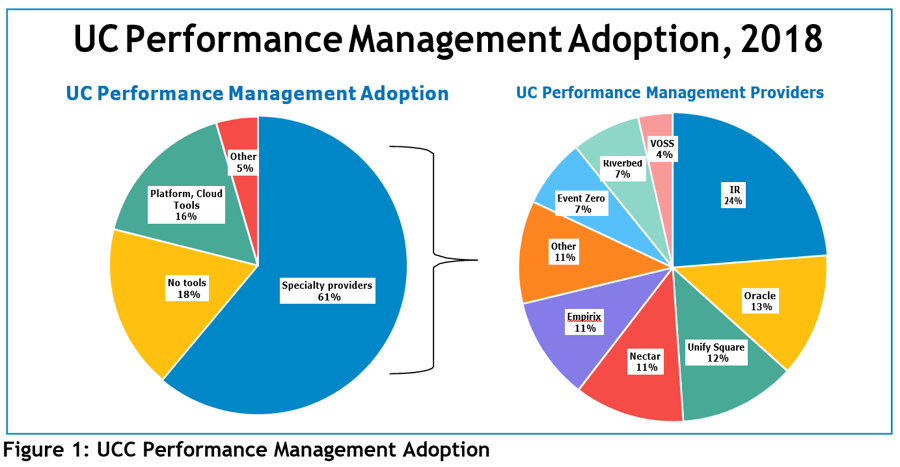
Among the 653 participants of Nemertes 2018-19 Unified Communications and Collaboration study, 61% use specialty providers (either single or multi-vendor tools). IR has the largest percentage of customers, with 24% stating they use the provider as their primary performance management vendor. (Please see Figure 1.)
Two primary issues inhibit early success at many organizations: They either do not use any performance management tools, or they wait too long to implement them. Performance management should be part of the initial Request for Proposal (RFP) and associated budget. Unfortunately, companies often ignore or cut that spending. Typically, one to two years post-deployment, they realize they need the insight performance management tools provide.
Single- or Multi-Vendor Solution
As IT leaders contemplate their performance management solution, they must decide whether to use a provider that can manage multiple UCC platforms or just a single UCC platform.
Most third-party UCC performance management tools manage multiple UCC platform vendors, though the number and combination of vendors managed varies. Most manage Cisco and/or Microsoft; others may include Alcatel-Lucent, Avaya, or Mitel.
They also may manage more than just the UCC platform. For example, some manage SBCs, endpoints, video conferencing rooms and networks, and contact-center platforms. The value to this approach is that the IT staff learns one management tool—and multi-vendor data shows up on a single pane of glass.
Other specialty performance management providers only manage a single UCC platform. They may or may not add additional management functions for endpoints, network, SBC, etc. The upside is advanced expertise for the chosen platform; the downside is the need for additional tools if the company uses more than one UCC provider or adds one in the future.
Digital Customer Experience Transformation
One of the big reasons companies need reliable real-time collaboration apps is their focus on Digital Customer Experience (DCX) transformations. According to our research, 85% of organizations have or are planning a DCX strategy. They are leveraging a variety of technologies and associated analytics to deliver value to customers over digital channels— web chat, video, SMS, screen sharing, etc.
IT staffs, particularly for larger organizations, must serve two sets of customers. The “customer” can be the employees or the end customer buying the company’s products or services.
Increasingly, they are leveraging technology in the contact center for employees, and extending employee collaboration tools to customers. As a result, UCC apps are crucial to delivering digital services. For example, one financial services organization extends all of its Cisco collaboration capabilities to high-net-worth clients. They can see their account team’s presence status, and then communicate via IM, voice, video, or screen sharing. Others echoed this model, leveraging federation and WebRTC to make it happen.
All of those require high-performing UCC apps to ensure the customer has a good experience and continues to value the relationship with the company. As the line between external and internal customers continue to blur, it’s important for IT staffs to integrate and manage the technologies for both groups.
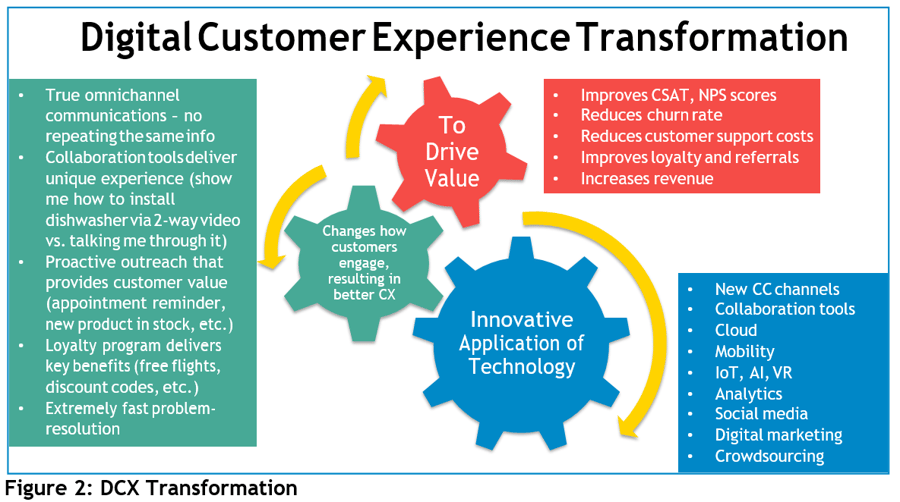
Figure 2 illustrates how companies achieve a DCX transformation. Once they have defined a business need, they add or use an existing technology in an innovative way. That, in turn, changes how customers engage, with the goal of improving their overall experience. (The green box in Figure 2 provides some examples.) Ultimately, this drives value, defined as increased revenue, decreased costs, improved customer satisfaction, reduced customer churn or employee turnover, or more loyalty and referrals.
The Role of Performance Management in DCX Transformation
Why, then, is performance management such a crucial part of an organization’s DCX transformation? Without performance management tools, the technology simply does not perform as well as it could. For example, take an appliance company adding video as a communications channel in an effort to improve the customer experience during installation or troubleshooting. If the video isn’t properly managed, customers may experience latency, jitter, or disconnections. That results in frustrated customers with declining experiences. As they receive post-call, Net Promoter Score (NPS), or customer satisfaction surveys, they rate the experience low. And the transformation initiative fails.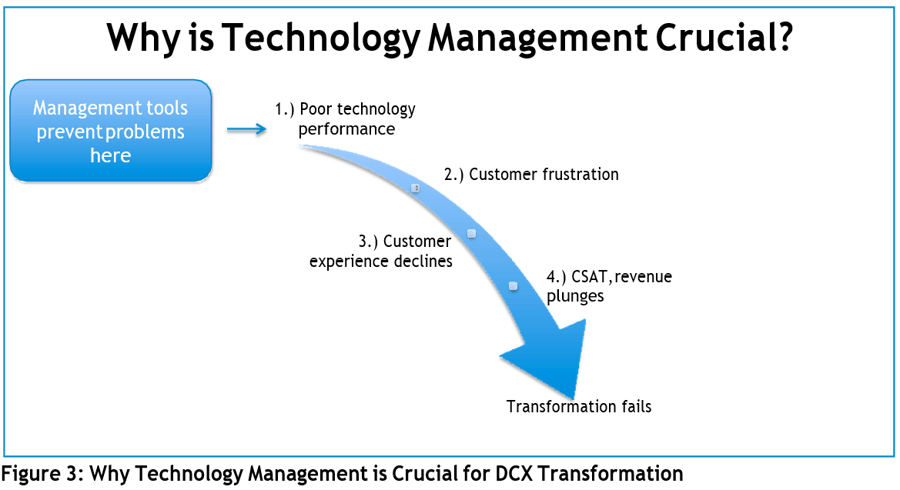
Collaboration’s Benefits to Customer Experience
Unified Communications and Collaboration apps deliver direct benefits to customer experience. Some of those benefits include the following:
-
Faster response time – By extending collaborative apps, such as presence/IM, to customers, they are able to reach the right person at the right time, through the best channel. Additionally, mobile enabling collaboration gives customers access to their desired apps from anywhere, getting them what they need quickly.
-
Richer experience – By adding video conferencing or screen sharing, vs. a simple text or voice call, customers have a better interaction. This could result in higher satisfaction scores or increased sales because they are able to see a product vs. just hearing about it.
-
Reduced cost – Organizations have found they need fewer staff members in the contact center because of increases in self-service capabilities. What’s more, adding team collaboration helps internal staffs find documents, meeting notes, and chat streams quickly. That productivity translates into saved time and money.
-
Higher customer satisfaction scores – Faster, richer interactions available via mobile channels result in happier customers who rate companies higher. Companies can promote their high customer satisfaction scores to attract new customers.
-
Increased sales – By extending collaboration capabilities to customers (select or all), the chance of upsell increases through new channels or simply by connecting with a customer who is ready to buy. That will increase sales.
How Does Performance Management Help?
Performance management tools keep the collaboration apps needed to improve customer experience operating smoothly. By predicting issues before they become problems, and determining root cause of outages, the tools ensure UCC is delivering the desired experience. But they also have additional benefits. Our research has documented some key areas. Those include operational cost reduction, improved employee productivity, and problem avoidance resulting from being proactive vs. reactive.
Operational Cost Reduction
Among companies with more than 1,000 licenses, UCC operational costs drop 43% when they use specialty tools vs. none at all. (Please see Figure 4.)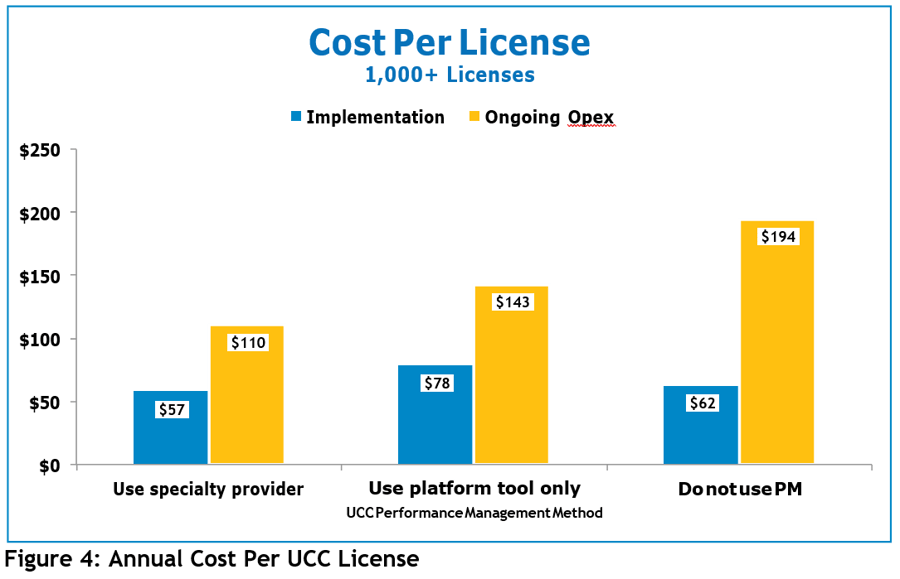
We measured how much each research participant spent on ongoing operational costs, which include IT staffing, managed services, equipment maintenance, subscriptions, IT and staff training and certification. We added those figures and divided by the number of licenses to arrive at an annual UCC operational cost, per license.
Figure 4 shows the difference in both implementation and annual operational costs, on average, based on whether they are using specialty providers, platform tools, or no performance management at all. Simply put, by leveraging performance management tools, organizations were able to reduce their ongoing UCC operational costs.
Typically, companies with performance management tools do not need as many IT staff members devoted to operating or managing the UCC platform or service. This is where the cost savings is derived. They also reduce the amount they spend on managed services. The tools automate functions, such as root cause analysis, that typically require manual intervention without the tools.
Improved Employee Productivity
We also measured by what percentage collaboration apps increase productivity. The largest percentage of companies said employee productivity increased between 5% and 20%.(Please see Figure 5.) In comparing the productivity increase among those who use or don’t use performance management tools, we see an improvement in productivity among those who use the tools. Those without performance management tools see a 16% average productivity increase among employees, compared to a 21% increase among those who do use specialty management tools. Essentially, the tools ensure the collaboration apps are working optimally. Outages, jitter, or other slow-downs will decrease the productivity of employees who rely on the collaboration apps to do their jobs.
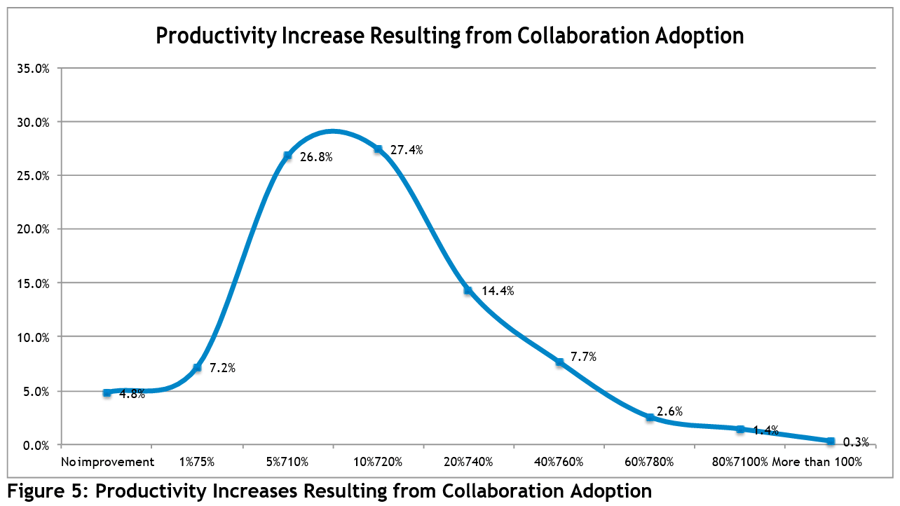
Proactive vs. Reactive Benefits
Performance management tools also allow IT staffs to be more proactive in their oversight of the apps. For example, by analyzing real-time and historical reports, along with alerts and utilization, they may find that current conditions are similar to a previous time frame that precipitated a major outage. They can take steps to prevent another outage.
IT staffs also can evaluate reporting data to correlate which UCC apps are most widely used, which times a day, and for which functions. For example, the tools may track meeting productivity when video conferencing is used or not used through post-meeting surveys.
They can proactively suggest to business units to consider video conferencing for more meetings because employees rate those meetings higher and they typically end 20 minutes earlier because employees are more productive on those meetings.
Conclusion
Nearly every organization uses UCC apps, and 85% of companies either have or are developing a DCX initiative for both internal and external customers. Specialty performance management tools help them to work optimally. Though 61% of organizations say they use specialty performance management providers, another 18% use no tools at all. And at least half of those who do use performance management do not implement performance management at the outset of their UCC implementation, delaying the many benefits, including the following:
- Top UCC performance results in more satisfied customers who count on the UCC apps to engage with the company, or for employees to collaborate with one
- Reduction in UCC operational costs by an average of 43% for companies with more than 1,000 licenses, driven in part by spending less time troubleshooting
- Improved employee productivity from 16% without performance management tools to 21% with them, driven in part by detecting the root cause of problems to reduce the time internal and external customers are
- Avoidance of downtime and outages by proactively analyzing when conditions are ripe for problems and taking steps to avoid
Nemertes recommends organizations consider these benefits when evaluating their overall UCC strategies. Plan for specialty performance management tools, which provide more data, analysis, and insight than platform-provided tools. And buy the tools at the outset of any new or replacement deployment.
Download a PDF copy of the Nemertes report
About Nemertes: Nemertes is a global research-based advisory and consulting firm that analyzes the business value of emerging technologies. Since 2002, we have provided strategic recommendations based on data-backed operational and business metrics to help enterprise organizations deliver successful technology transformation to employees and customers. Simply put: Nemertes’ better data helps clients make better decisions.



